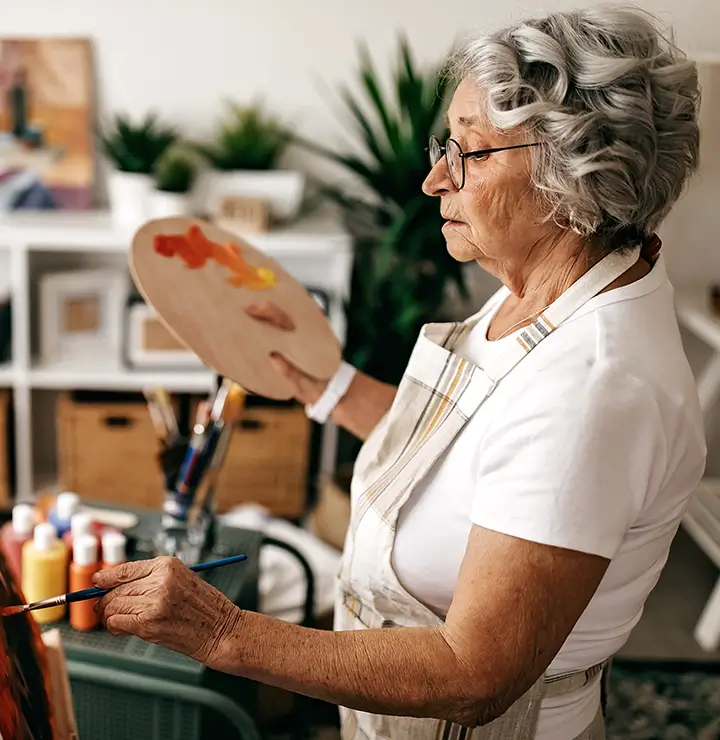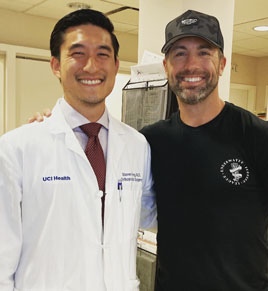
Osteoarthritis
The orthopaedic specialists at UCI Health provide surgical and nonsurgical treatment and recovery options for patients suffering from osteoarthritis.
At UCI Health, our orthopaedic specialists can help reduce your pain, restore joint mobility and improve your overall quality of life.
They will work with you to find the best, most comprehensive treatment plan, including surgical and nonsurgical options.
Symptoms of osteoarthritis
As osteoarthritis progresses, you will experience loss of cartilage, bone spurs around the affected joint and muscle weakness of the extremity.
The symptoms of osteoarthritis often begin gradually, then worsen over time. Signs of a problem include:
- Joint pain, especially after overuse or long periods of inactivity, such as sitting for a long time
- Creaking or grating sounds in the joint
- Swelling, stiffness, limited movement of the joint, especially in the morning
- Weakness in muscles around the sore joint
- Deformity of the joint
You should see your doctor when you have joint pain or stiffness that lasts more than a few weeks.

Don’t let osteoarthritis hold you back
Get back to an active, pain-free lifestyle.
Call 714-456-7012 to schedule an appointment today or

Find an orthopaedics clinical trial
Talk to your doctor to see if a orthopaedics clinical trial is right for you.
Featured Blog Posts

Live Well’s most popular stories of 2023
Take a peek at our readers' favorite articles of the year.

Partial knee replacement revitalizes life of Marine

A novel approach to treating knee arthritis
A first-in-human clinical trial shows promise as a nonsurgical way to keep aging knees strong and pain-free.
Causes of osteoarthritis
There are several factors that put you at risk of developing osteoarthritis, including:
- Age: Your risk of developing osteoarthritis increases as you get older
- Sex: Women are at higher risk for getting osteoarthritis
- Deformities: Malformed joints or defective cartilage can increase the risk of osteoarthritis
- Injuries: Accidents and sports injuries may increase your risk
- Excess weight: Being overweight places more stress on weight-bearing joints, particularly your knees
Diagnosis and testing for osteoarthritis
If you are experiencing osteoarthritis symptoms, the first step is to schedule an appointment with your primary care physician.
Diagnosis
To determine if you have osteoarthritis, your physicians will conduct a physical exam, checking the affected joints for tenderness, redness or swelling. You will also be asked about the history of your pain.
Your physician may also order imaging and lab tests to further aid in making a diagnosis.
Testing
Tests may include:
- X-ray, which can show bone spurs around a joint and cartilage loss between the bone and the joint
- Blood tests, which can help rule out other causes of joint pain, such as rheumatoid arthritis
- Arthrocentesis, a procedure that involves withdrawing fluid from a joint for testing to identify the cause of joint pain
Treatment for osteoarthritis
There is no known cure for osteoarthritis, however, our orthopaedic specialists will work with you to create a comprehensive treatment plan to reduce your joint pain, lessen inflammation and improve joint function.Treatments may include a combination of:
Medications
- Over-the-counter pain medicine, such as acetaminophen (Tylenol) and nonsteroidal anti-inflammatory drugs (NSAIDs), such as ibuprofen (Advil) and naproxen (Aleve)
- Topical pain medicines, such as creams containing capsaicin
- Viscosupplementation, which is an injection of hyaluronan into the joint
- Corticosteroid injections
Mechanical aids
- Shock-absorbing shoe soles
- Canes, walkers, crutches and orthopedic shoes
Weight loss
Carrying excess weight results in additional stress on your joints. Losing just five pounds can reduce the weight impact on your joints by at least 15 pounds. The more you lose, the more you and your joints will benefit. Exercise and physical therapy
Strengthening your muscles around the arthritic joint — especially the knee, lower back and neck — can reduce pain and absorb energy around the joint.
Exercises may include:
- Cycling
- Swimming
- Strength training
Assistive devices
If arthritis pain is limiting your mobility, your physician may recommend assistive devices to help you and prevent accidents, including
- Handrails and grips installed in your shower,
- Elevated toilet seats for easier rising after sitting
Heat and ice
Heat helps keep your joints and muscles moving easily and reduces pain. Using ice after activity can help with pain and reduce any swelling.Steroids
You may be given corticosteroid injections to the inflamed joint if other pain medicines do not work. Because repeated cortisone injections can be harmful to cartilage, they are reserved for those with severe symptoms.Surgery
If conservative treatments don't alleviate your pain and discomfort, surgery may be an option. There are two types of surgical procedures:
- Osteotomy: This procedure repositions the bones to redistribute stress on the joint.
- Joint replacement: In total or partial joint replacement, the damaged joint surfaces are replaced with plastic and metal devices (called prostheses).
Prevention
Our physicians put an emphasis on prevention. The less stress you place on your joints, the less likely they are to wear out prematurely.
To reduce your chance of getting osteoarthritis:
- Maintain a healthy weight
- Do regular, gentle exercise (for example, walking, stretching, swimming or yoga)
- Avoid repetitive motions and risky activities that may contribute to joint injury, especially after age 40
- Maintain good posture to keep excessive pressure off your joints
- Wear protective equipment, such as wrist pads and helmets, to protect your joints




